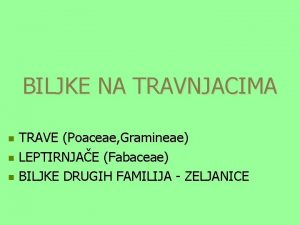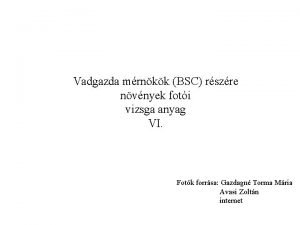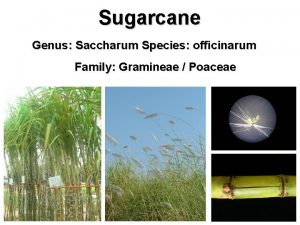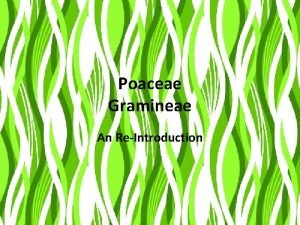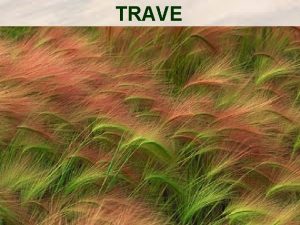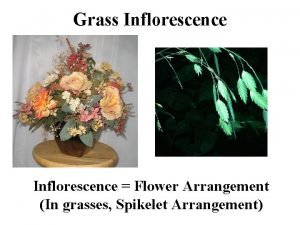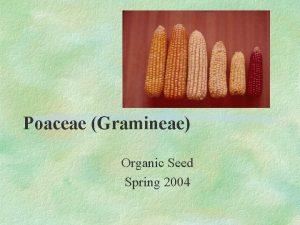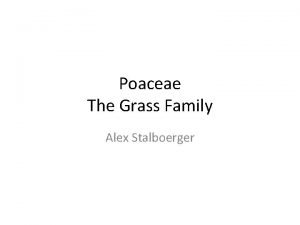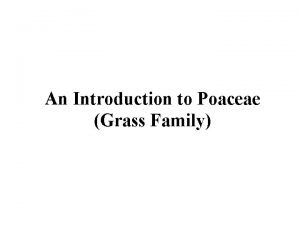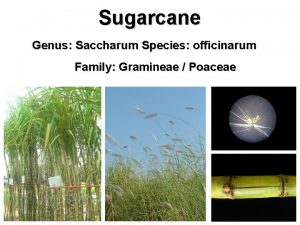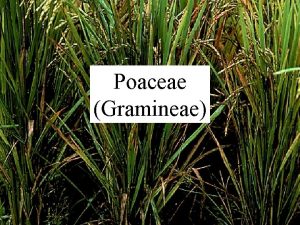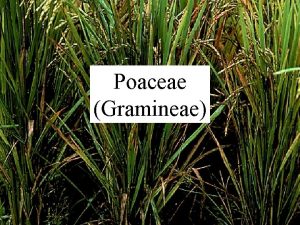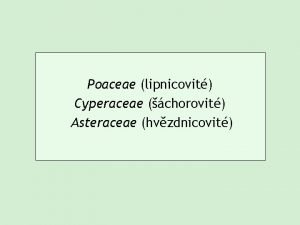Commelinanae II Poaceae Gramineae the grass family 650














- Slides: 14


Commelinanae II Poaceae (Gramineae) -- the grass family (650 -660/10, 000; cosmopolitan) Plants flowering, synoecious or monoecious; stems mostly round with swollen nodes and mostly hollow (sometimes a pith); intercalary meristems Habit herbs, shrubs or trees; rhizomatous or stoloniferous Leaves alternate, sometimes basal; simple; two ranked; leaf bases with open sheath surrounding stem, upper margins of the sheath may bear small ear-like apical lobes called auricles; parallel venation; ligulate; blades flat or absent Inflorescences spikes and spikelets that are 2º clustered into inflorescences (spikes, racemes, or panicles); each spikelet subtended by 2 basal bracts (glumes), within the spikelet, each flower subtended by two bractlets (lemma to the outside/palea to the inside) all attached to the rachilla; glumes or lemma can be ornamented with awns Flowers zygomorphic, perfect or imperfect, hypogynous, small and conspicuous, subtended by lemma and palea; lodicules interpreted as reduced perianth; wind-pollinated Perianth 1 -3 lodicules distinct, fleshy and becoming turgid at anthesis Androecium 3 (1 -2 or 4 -6) stamens, distinct Gynoecium superior; 1 pistil of 3 connate carpels (only 2 apparent); 1 locule; 1 ovule/locule, basal placentation, usually adnate to ovary wall; styles 2 (1 or 3), distinct or united; stigma plumose or papillose Fruit caryopsis (achene, utricle, nut, or drupe), often shed together with enclosing bracts (Floral formula: A 3 G 2 )

Commelinanae II Poaceae -- comments Genera: Triticum spp. (wheat), Avena sativa (oats), Zea mays (corn), Oryza sativa (rice), Saccharum officinarum (sugar cane), Hordeum vulgare (barley), Sorghum bicolor (sorghum), Secale (rye), Bambusa spp. (bamboo) Comments: Without a doubt, the most important family in the average human’s life! If aliens were to land on this planet and take a quick look around, they would probably describe a planet in which the grasses had millions of human slaves tending to their every need. . . Rice feeds more humans than any other grain. “Wild rice” is actually a different species (Zizania aquatica) and is native to North America. Wild rice has a bit more, nutrition-wise, than rice, but the bracts are harder to separate from the fruit, and is more expensive to harvest. As well as the grains that we eat, grass is very important as fodder for many of our livestock. Range management has become very important in the West (after overgrazing and catastrophic droughts killed lots of cattle in the past), and you can take courses that concentrate only on grasses!!










Commelinanae II Poaceae -- comments Comments: Several species of bamboo (Bambusa sp. ), are used not only as food, but also for timber, pulp, and utensils. Some bamboos grow vegetatively for years (up to 150 yrs), flower, and then die. This has caused problems in the past (particularly for pandas) because clones can spread over large areas of land, and when it is time for that plant to flower all the clones simultaneously flower and die. Ornamental uses for grasses include turf-grasses (billions and billions of dollars are spent on residential and commercial lawns every year) such as St. Augustine grass and Bermuda grass (Cynodon sp. ), and as accent plants in perennial borders and the landscape. Fermented grains are the main source of many alcoholic beverages, and some anthropologists have theorized that these recreational drinks may have had a profound effect on the beginnings of agriculture!

